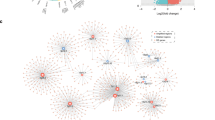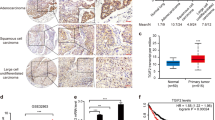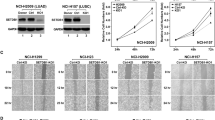Abstract
In many types of cancers, the fragile histidine triad (Fhit) gene is frequently targeted by genomic alterations leading to a decrease or loss of gene and protein expression. Fhit has been described as a tumor suppressor gene because of its ability to induce apoptosis and to inhibit proliferation of tumor cells. Moreover, several studies have shown a correlation between the lack of Fhit expression and tumor aggressiveness, thus suggesting that Fhit could be involved in tumor progression. In this study, we explored the potential role of Fhit during tumor cell invasion. We first showed that a low Fhit expression is associated with in vivo and in vitro invasiveness of tumor cells. Then, we showed that Fhit overexpression in Fhit-negative highly invasive NCI-H1299 cells by transfection of Fhit cDNA and Fhit inhibition in Fhit-positive poorly invasive HBE4-E6/E7 cells by transfection of Fhit small interfering RNA induce, respectively, a decrease and an increase in migratory/invasive capacities. These changes in cell behavior were associated with a reorganization of tight and adherens junction molecules and a regulation of matrix metalloproteinase and vimentin expression. These results show that Fhit controls the invasive phenotype of lung tumor cells by regulating the expression of genes associated with epithelial–mesenchymal transition.
This is a preview of subscription content, access via your institution
Access options
Subscribe to this journal
Receive 50 print issues and online access
$259.00 per year
only $5.18 per issue
Buy this article
- Purchase on Springer Link
- Instant access to full article PDF
Prices may be subject to local taxes which are calculated during checkout






Similar content being viewed by others
Accession codes
References
Barnes LD, Garrison PN, Siprashvili Z, Guranowski A, Robinson AK, Ingram SW et al. (1996). Fhit, a putative tumor suppressor in humans, is a dinucleoside 5′,5″′-P1,P3-triphosphate hydrolase. Biochemistry 35: 11529–11535.
Brabletz T, Jung A, Dag S, Hlubek F, Kirchner T . (1999). beta-Catenin regulates the expression of the matrix metalloproteinase-7 in human colorectal cancer. Am J Pathol 155: 1033–1038.
Campiglio M, Bianchi F, Andriani F, Sozzi G, Tagliabue E, Menard S et al. (2006). Diadenosines as FHIT-ness instructors. J Cell Physiol 208: 274–281.
Cavazzoni A, Petronini PG, Galetti M, Roz L, Andriani F, Carbognani P et al. (2004). Dose-dependent effect of FHIT-inducible expression in Calu-1 lung cancer cell line. Oncogene 23: 8439–8446.
Chang C, Werb Z . (2001). The many faces of metalloproteases: cell growth, invasion, angiogenesis and metastasis. Trends Cell Biol 11: S37–S43.
Crawford HC, Fingleton BM, Rudolph-Owen LA, Goss KJ, Rubinfeld B, Polakis P et al. (1999). The metalloproteinase matrilysin is a target of beta-catenin transactivation in intestinal tumors. Oncogene 18: 2883–2891.
Dumon KR, Ishii H, Fong LY, Zanesi N, Fidanza V, Mancini R et al. (2001). FHIT gene therapy prevents tumor development in Fhit-deficient mice. Proc Natl Acad Sci USA 98: 3346–3351.
Gavert N, Ben Ze'ev A . (2007). beta-Catenin signaling in biological control and cancer. J Cell Biochem 102: 820–828.
Gavert N, Ben Ze'ev A . (2008). Epithelial–mesenchymal transition and the invasive potential of tumors. Trends Mol Med 14: 199–209.
Gilles C, Polette M, Mestdagt M, Nawrocki-Raby B, Ruggeri P, Birembaut P et al. (2003). Transactivation of vimentin by beta-catenin in human breast cancer cells. Cancer Res 63: 2658–2664.
Gilles C, Polette M, Piette J, Delvigne AC, Thompson EW, Foidart JM et al. (1996). Vimentin expression in cervical carcinomas: association with invasive and migratory potential. J Pathol 180: 175–180.
Gilles C, Polette M, Zahm JM, Tournier JM, Volders L, Foidart JM et al. (1999). Vimentin contributes to human mammary epithelial cell migration. J Cell Sci 112 (Part 24): 4615–4625.
Gilles C, Thompson EW . (1996). The epithelial to mesenchymal transition and metastatic progression in carcinoma. Breast J 2: 83–96.
Hazgui S, Bonnet N, Cutrona J, Nawrocki-Raby B, Polette M, Chouchane L et al. (2005). 3D culture model and computer-assisted videomicroscopy to analyze migratory behavior of noninvasive and invasive bronchial epithelial cells. Am J Physiol Cell Physiol 289: C1547–C1552.
Hendrix MJ, Seftor EA, Seftor RE, Trevor KT . (1997). Experimental co-expression of vimentin and keratin intermediate filaments in human breast cancer cells results in phenotypic interconversion and increased invasive behavior. Am J Pathol 150: 483–495.
Huebner K, Croce CM . (2003). Cancer and the FRA3B/FHIT fragile locus: it's a HIT. Br J Cancer 88: 1501–1506.
Ishii H, Dumon KR, Vecchione A, Fong LY, Baffa R, Huebner K et al. (2001). Potential cancer therapy with the fragile histidine triad gene: review of the preclinical studies. JAMA 286: 2441–2449.
Jayachandran G, Sazaki J, Nishizaki M, Xu K, Girard L, Minna JD et al. (2007). Fragile histidine triad-mediated tumor suppression of lung cancer by targeting multiple components of the Ras/Rho GTPase molecular switch. Cancer Res 67: 10379–10388.
Ji L, Fang B, Yen N, Fong K, Minna JD, Roth JA . (1999). Induction of apoptosis and inhibition of tumorigenicity and tumor growth by adenovirus vector-mediated fragile histidine triad (FHIT) gene overexpression. Cancer Res 59: 3333–3339.
Lee JM, Dedhar S, Kalluri R, Thompson EW . (2006). The epithelial–mesenchymal transition: new insights in signaling, development, and disease. J Cell Biol 172: 973–981.
Luo J, Lubaroff DM, Hendrix MJ . (1999). Suppression of prostate cancer invasive potential and matrix metalloproteinase activity by E-cadherin transfection. Cancer Res 59: 3552–3556.
Marchenko GN, Marchenko ND, Leng J, Strongin AY . (2002). Promoter characterization of the novel human matrix metalloproteinase-26 gene: regulation by the T-cell factor-4 implies specific expression of the gene in cancer cells of epithelial origin. Biochem J 363: 253–262.
Maruyama R, Sugio K, Yoshino I, Maehara Y, Gazdar AF . (2004). Hypermethylation of FHIT as a prognostic marker in nonsmall cell lung carcinoma. Cancer 100: 1472–1477.
Nakagawa Y, Akao Y . (2006). Fhit protein inhibits cell growth by attenuating the signaling mediated by nuclear factor-kappaB in colon cancer cell lines. Exp Cell Res 312: 2433–2442.
Nakata S, Sugio K, Uramoto H, Oyama T, Hanagiri T, Morita M et al. (2006). The methylation status and protein expression of CDH1, p16(INK4A), and fragile histidine triad in nonsmall cell lung carcinoma: epigenetic silencing, clinical features, and prognostic significance. Cancer 106: 2190–2199.
Nawrocki-Raby B, Gilles C, Polette M, Martinella-Catusse C, Bonnet N, Puchelle E et al. (2003). E-Cadherin mediates MMP down-regulation in highly invasive bronchial tumor cells. Am J Pathol 163: 653–661.
Negrini M, Monaco C, Vorechovsky I, Ohta M, Druck T, Baffa R et al. (1996). The FHIT gene at 3p14.2 is abnormal in breast carcinomas. Cancer Res 56: 3173–3179.
Ohta M, Inoue H, Cotticelli MG, Kastury K, Baffa R, Palazzo J et al. (1996). The FHIT gene, spanning the chromosome 3p14.2 fragile site and renal carcinoma-associated t(3;8) breakpoint, is abnormal in digestive tract cancers. Cell 84: 587–597.
Pace HC, Garrison PN, Robinson AK, Barnes LD, Draganescu A, Rosler A et al. (1998). Genetic, biochemical, and crystallographic characterization of Fhit-substrate complexes as the active signaling form of Fhit. Proc Natl Acad Sci USA 95: 5484–5489.
Pekarsky Y, Garrison PN, Palamarchuk A, Zanesi N, Aqeilan RI, Huebner K et al. (2004). Fhit is a physiological target of the protein kinase Src. Proc Natl Acad Sci USA 101: 3775–3779.
Pekarsky Y, Zanesi N, Palamarchuk A, Huebner K, Croce CM . (2002). FHIT: from gene discovery to cancer treatment and prevention. Lancet Oncol 3: 748–754.
Polette M, Gilles C, Nawrocki-Raby B, Lohi J, Hunziker W, Foidart JM et al. (2005). Membrane-type 1 matrix metalloproteinase expression is regulated by zonula occludens-1 in human breast cancer cells. Cancer Res 65: 7691–7698.
Polette M, Mestdagt M, Bindels S, Nawrocki-Raby B, Hunziker W, Foidart JM et al. (2007). Beta-catenin and ZO-1: shuttle molecules involved in tumor invasion-associated epithelial–mesenchymal transition processes. Cells Tissues Organs 185: 61–65.
Polette M, Nawrocki-Raby B, Gilles C, Clavel C, Birembaut P . (2004). Tumour invasion and matrix metalloproteinases. Crit Rev Oncol Hematol 49: 179–186.
Pylkkanen L, Wolff H, Stjernvall T, Tuominen P, Sioris T, Karjalainen A et al. (2002). Reduced Fhit protein expression and loss of heterozygosity at FHIT gene in tumours from smoking and asbestos-exposed lung cancer patients. Int J Oncol 20: 285–290.
Reichert M, Muller T, Hunziker W . (2000). The PDZ domains of zonula occludens-1 induce an epithelial to mesenchymal transition of Madin-Darby canine kidney I cells. Evidence for a role of beta-catenin/Tcf/Lef signaling. J Biol Chem 275: 9492–9500.
Roz L, Gramegna M, Ishii H, Croce CM, Sozzi G . (2002). Restoration of fragile histidine triad (FHIT) expression induces apoptosis and suppresses tumorigenicity in lung and cervical cancer cell lines. Proc Natl Acad Sci USA 99: 3615–3620.
Seiki M . (2003). Membrane-type 1 matrix metalloproteinase: a key enzyme for tumor invasion. Cancer Lett 194: 1–11.
Semba S, Trapasso F, Fabbri M, McCorkell KA, Volinia S, Druck T et al. (2006). Fhit modulation of the Akt-survivin pathway in lung cancer cells: Fhit-tyrosine 114 (Y114) is essential. Oncogene 25: 2860–2872.
Siprashvili Z, Sozzi G, Barnes LD, McCue P, Robinson AK, Eryomin V et al. (1997). Replacement of Fhit in cancer cells suppresses tumorigenicity. Proc Natl Acad Sci USA 94: 13771–13776.
Sozzi G, Pastorino U, Moiraghi L, Tagliabue E, Pezzella F, Ghirelli C et al. (1998). Loss of FHIT function in lung cancer and preinvasive bronchial lesions. Cancer Res 58: 5032–5037.
Sozzi G, Veronese ML, Negrini M, Baffa R, Cotticelli MG, Inoue H et al. (1996). The FHIT gene 3p14.2 is abnormal in lung cancer. Cell 85: 17–26.
Takahashi M, Tsunoda T, Seiki M, Nakamura Y, Furukawa Y . (2002). Identification of membrane-type matrix metalloproteinase-1 as a target of the beta-catenin/Tcf4 complex in human colorectal cancers. Oncogene 21: 5861–5867.
Tobioka H, Isomura H, Kokai Y, Tokunaga Y, Yamaguchi J, Sawada N . (2004). Occludin expression decreases with the progression of human endometrial carcinoma. Hum Pathol 35: 159–164.
Trapasso F, Krakowiak A, Cesari R, Arkles J, Yendamuri S, Ishii H et al. (2003). Designed FHIT alleles establish that Fhit-induced apoptosis in cancer cells is limited by substrate binding. Proc Natl Acad Sci USA 100: 1592–1597.
Van Aken E, De Wever O, Correia da Rocha AS, Mareel M . (2001). Defective E-cadherin/catenin complexes in human cancer. Virchows Arch 439: 725–751.
Weiske J, Albring KF, Huber O . (2007). The tumor suppressor Fhit acts as a repressor of beta-catenin transcriptional activity. Proc Natl Acad Sci USA 104: 20344–20349.
Zahm JM, Kaplan H, Herard AL, Doriot F, Pierrot D, Somelette P et al. (1997). Cell migration and proliferation during the in vitro wound repair of the respiratory epithelium. Cell Motil Cytoskeleton 37: 33–43.
Acknowledgements
This study was supported by the Région Champagne-Ardenne, the Ligue Contre le Cancer (Comité de la Marne), the Lions Club of Soissons, Un Euro contre le Cancer and the Fond National pour la Santé ACI 2004–2010 INCa (Cancéropôle Grand-Est project).
Author information
Authors and Affiliations
Corresponding author
Additional information
Supplementary Information accompanies the paper on the Oncogene website (http://www.nature.com/onc)
Supplementary information
Rights and permissions
About this article
Cite this article
Joannes, A., Bonnomet, A., Bindels, S. et al. Fhit regulates invasion of lung tumor cells. Oncogene 29, 1203–1213 (2010). https://doi.org/10.1038/onc.2009.418
Received:
Revised:
Accepted:
Published:
Issue Date:
DOI: https://doi.org/10.1038/onc.2009.418
Keywords
This article is cited by
-
Tanshinones induce tumor cell apoptosis via directly targeting FHIT
Scientific Reports (2021)
-
Genome-wide association and expression quantitative trait loci studies identify multiple susceptibility loci for thyroid cancer
Nature Communications (2017)
-
Association of activated Gαq to the tumor suppressor Fhit is enhanced by phospholipase Cβ
BMC Cancer (2015)
-
FHIT loss confers cisplatin resistance in lung cancer via the AKT/NF-κB/Slug-mediated PUMA reduction
Oncogene (2015)
-
The FHIT gene product: tumor suppressor and genome “caretaker”
Cellular and Molecular Life Sciences (2014)



